Fery
International Hazard
    
Posts: 1026
Registered: 27-8-2019
Location: Czechoslovakia
Member Is Offline
|
|
Ni(IV) - periodatonickelates
KNiIO6 . 1/2 H2O
Dissolve 3,0 g KIO4 in 500 ml boiling water in 1 l Erlenmayer flask, then add 2,0 g NiSO4 . 6 H2O, dissolve (solution is not completely clear, there
is a turbidity). To the boiling solution add 4,0 g of K2S2O8 in 0,4 g portions during 30 minutes. The solution must be stirred. When adding K2S2O8
into the boiling solution it seems to immediately decompose into O2. So I suggest to add it few seconds after removing the flask from the heat when
the boil ceases while swirling the flask by hand, then no such vigorous production of O2 bubbles. Then let it to boil for 10 minutes. Allow black very
fine crystals to settle. Small additional amount of the product obtained when the same procedure repeated with the supernatant (adding 4,0 g K2SO4 to
it). Decant the product 3 times with 100 ml of 1% hot K2S2O8 and 3 times with 100 ml of hot water acidified with HNO3 (0,5 ml HNO3 into 300 ml of
water), transfer to sintered funnel and dry with suction. Sintered glas No 2. is not dense enough and the crystals pass through it, you must use
denser sinter (No 4.). Do not use filter paper as it reduces the product. Dry out over CaCl2. Yield 0,53 g.
Use 10% oxalic acid to clean the glass (few minutes required, but it dissolves completely at the end).
some info here:
https://www.sciencemadness.org/whisper/viewthread.php?tid=72...
https://en.wikipedia.org/wiki/Periodatonickelates
photos will follow
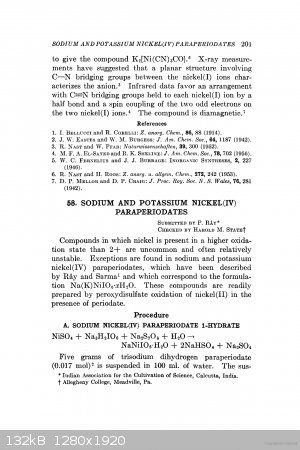   
Attachment: currie1994.pdf (604kB)
This file has been downloaded 345 times
Attachment: v69-630.pdf (162kB)
This file has been downloaded 369 times
[Edited on 10-2-2020 by Fery]
|
|
|
Fery
International Hazard
    
Posts: 1026
Registered: 27-8-2019
Location: Czechoslovakia
Member Is Offline
|
|
photos
reactants - KIO4, NiSO4 . 6 H2O, K2S2O8
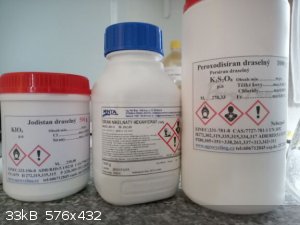
3,0 g KIO4 + 500 ml H2O + 2,0 g NiSO4 . 6 H2O
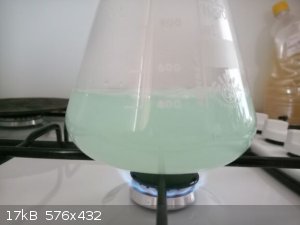
after addition of first 0,4 g K2S2O8
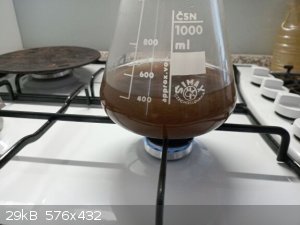
after addition of all 4,0 g K2S2O8

a mirror formed on the flask

boil for 10 minutes

the mirror is reddish from inside of the flask
  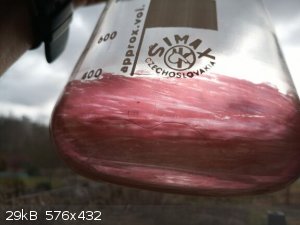
but it reflects the light from outside of the flask
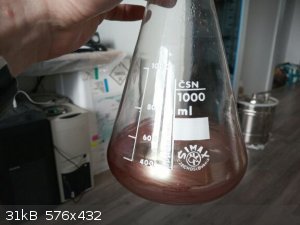 
small additional amount of product obtained when the procedure repeated with supernatant (adding K2S2O8 into it)
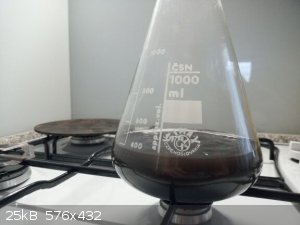
the product KNiIO6 . 1/2 H2O

[Edited on 10-2-2020 by Fery]
|
|
|
woelen
Super Administrator
        
Posts: 8027
Registered: 20-8-2005
Location: Netherlands
Member Is Offline
Mood: interested
|
|
Interesting material. I once made this material accidentally, in an attempt to make something else. I obtained a very dark red solution and
interesting crystals. According to the wiki page about this material, it can be used to make perbromates. I think that in practice, however, this will
be very challenging. Isolating the perbromate from all that nickel, periodate and bromate in the solution will be a difficult task, requiring many
steps.
|
|
|
Tdep
National Hazard
   
Posts: 519
Registered: 31-1-2013
Location: Laser broken since Feb 2020 lol
Member Is Offline
Mood: PhD is done! It isn't good but it's over lol
|
|
I really want to believe that you can use KNiIO6 to make perbromate. But looking at the journal article doesn't give me much hope even before opening it.
Its published in some no-name journal with an impact factor of 0.17 and had only 4 issues... fine sure, then the paper has 11 citations, which is
nice, but 10 out of 11 of them are from the same author 'Sharanappa T Nandibewoor', so that's not a great sign. Not citations from the other
perbromate literature?
This perbromate paper from 2011 did not mention Nandibewoor's work at all for example.
Ok sure, maybe they missed it. But I don't like the paper I gotta say. I think the main thing that you need to do when making some sort of exotic
species is prove that you actually made the thing. How do they try and convince you they made it?UV-Vis. Yeah. And it gets worse.
Because do they actually show that data? No. They just link to papers from the 1960s (!) and 70s and say 'it matched this'!!
If I want to procrastinate more work later today, I'll look up the 1960s references and find the UV-Vis data, but given its a colourless anion, I find
it hard to believe it would be easily distinguished from periodate or bromate in this way
 
|
|
|
Fery
International Hazard
    
Posts: 1026
Registered: 27-8-2019
Location: Czechoslovakia
Member Is Offline
|
|
woelen and Tdep, if you are interested in NaBrO4 then it is easier to separate it when reacting NaBrO3 + NaOBr at 40 C for few
days - weeks
oxidation by F2 is not easy to done in home lab
also oxidation using Ni(IV) diperiodonickelate attached, but only kinetics, not the isolation of the product
Attachment: pisarenko2011.pdf (1.4MB)
This file has been downloaded 367 times
Attachment: bilehal2002.pdf (98kB)
This file has been downloaded 330 times
Attachment: appelman1969.pdf (619kB)
This file has been downloaded 493 times
|
|
|
Justin Blaise
Hazard to Self
 
Posts: 82
Registered: 5-10-2011
Location: Parts Unknown
Member Is Offline
Mood: No Mood
|
|
Very cool compound. I wonder if it's an energetic oxidant with things like sugar or Al powder.
|
|
|